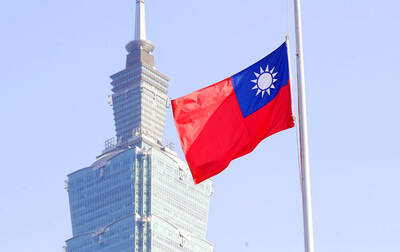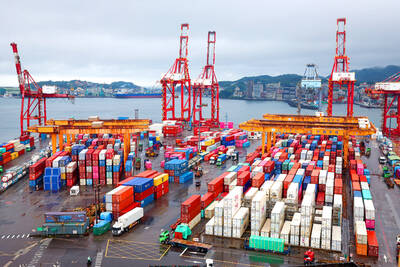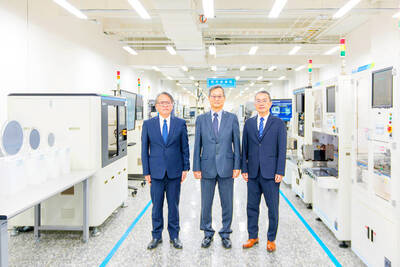Taiwan’s banking sector is likely to see another loss-making year and post minus 0.5 percent return-on-assets (ROA) this year — the worst-performing among its peers in the Asia-Pacific Region, Fitch Ratings Ltd forecast yesterday.
That will be worse than the sector’s two previous loss-making years in 2002 and 2006, when corporate bad loans and credit card and cash card defaults dragged down the ROA to minus 0.48 percent and minus 0.03 percent respectively, Jonathan Lee (李信佳), senior director of the financial institutions group at Fitch’s Taipei branch, told a media briefing.
“The local banking sector has been doing poorly in diversifying sales of its financial products and internal risk control,” Lee said.
The sector is now facing mounting pressure to recapitalize since the average capital adequacy ratio is likely to drop to 6 percent, below the statutory 8 percent, he said.
Banks in Taiwan and Japan, which Fitch forecast would register an averaged 0.1 percent ROA this year, will underperform other Asian countries, including the two most profitable in Indonesia and Malaysia, which are forecast to report a 1.3 percent ROA and a 0.8 percent ROA respectively this year, he said.
Compared to its peers in the US and the EU, Fitch said the Asian banking sector would weather the recent financial crisis quicker and better. The ratings agency forecast Asian economies would see an averaged 4 percent GDP growth next year, up from a projected growth of 0.4 percent this year.
As of late last month, the global banking sector has raised US$1.041 trillion to write off losses totaling US$1.259 trillion, while the banking sector in North America has raised US$573.8 billion, not enough to write off losses of US$847.5 billion, Lee said.
Like its European peer, the Asian banking sector has raised US$71.1 billion, more than enough to write off its exposure of US$33.3 billion, which shows that the region has “the strongest financial strength, plus, Asian economies also are forecast to rebound the strongest [next year],” Lee said.
But Lee expressed concern over the insurance sector, which he said would incur worse-than-expected losses this year because of unprofitable overseas investments and a negative interest spread.
He said the government’s planned Insurance Stability Fund with a capital pool of around NT$16 billion (US$481 million) would not be enough to rescue insurers in difficulty, when compared with the Financial Restructuring Fund’s NT$450 billion for bailing out banks.
In response, Wu Chung-chuan (吳崇權), deputy director of the Financial Supervisory Commission’s insurance bureau, said the bureau was mulling measures to facilitate an exit mechanism should some of the nation’s troubled life or non-life insurers require a bail-out from the government.
Wu, however, yesterday downplayed questions as to whether and how the commission planned to enlarge the insurance fund’s size.

ELECTRONICS BOOST: A predicted surge in exports would likely be driven by ICT products, exports of which have soared 84.7 percent from a year earlier, DBS said DBS Bank Ltd (星展銀行) yesterday raised its GDP growth forecast for Taiwan this year to 4 percent from 3 percent, citing robust demand for artificial intelligence (AI)-related exports and accelerated shipment activity, which are expected to offset potential headwinds from US tariffs. “Our GDP growth forecast for 2025 is revised up to 4 percent from 3 percent to reflect front-loaded exports and strong AI demand,” Singapore-based DBS senior economist Ma Tieying (馬鐵英) said in an online briefing. Taiwan’s second-quarter performance beat expectations, with GDP growth likely surpassing 5 percent, driven by a 34.1 percent year-on-year increase in exports, Ma said, citing government

‘REMARKABLE SHOWING’: The economy likely grew 5 percent in the first half of the year, although it would likely taper off significantly, TIER economist Gordon Sun said The Taiwan Institute of Economic Research (TIER) yesterday raised Taiwan’s GDP growth forecast for this year to 3.02 percent, citing robust export-driven expansion in the first half that is likely to give way to a notable slowdown later in the year as the front-loading of global shipments fades. The revised projection marks an upward adjustment of 0.11 percentage points from April’s estimate, driven by a surge in exports and corporate inventory buildup ahead of possible US tariff hikes, TIER economist Gordon Sun (孫明德) told a news conference in Taipei. Taiwan’s economy likely grew more than 5 percent in the first six months

SMART MANUFACTURING: The company aims to have its production close to the market end, but attracting investment is still a challenge, the firm’s president said Delta Electronics Inc (台達電) yesterday said its long-term global production plan would stay unchanged amid geopolitical and tariff policy uncertainties, citing its diversified global deployment. With operations in Taiwan, Thailand, China, India, Europe and the US, Delta follows a “produce at the market end” strategy and bases its production on customer demand, with major site plans unchanged, Delta president Simon Chang (張訓海) said on the sidelines of a company event yesterday. Thailand would remain Delta’s second headquarters, as stated in its first-quarter earnings conference, with its plant there adopting a full smart manufacturing system, Chang said. Thailand is the firm’s second-largest overseas

SUPPLY RESILIENCE: The extra expense would be worth it, as the US firm is diversifying chip sourcing to avert disruptions similar to the one during the pandemic, the CEO said Advanced Micro Devices Inc (AMD) chief executive officer Lisa Su (蘇姿丰) on Wednesday said that the chips her company gets from supplier Taiwan Semiconductor Manufacturing Co (TSMC, 台積電) would cost more when they are produced in TSMC’s Arizona facilities. Compared with similar parts from factories in Taiwan, the US chips would be “more than 5 percent, but less than 20 percent” in terms of higher costs, she said at an artificial intelligence (AI) event in Washington. AMD expects its first chips from TSMC’s Arizona facilities by the end of the year, Su said. The extra expense is worth it, because the company is